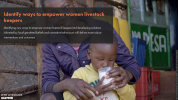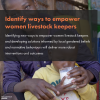
Identify ways to empower women livestock keepers
Identifying new ways to empower women livestock keepers and developing solutions informed by local gendered beliefs and normative behaviours will deliver more robust interventions and outcomes
Core message
Actions and Solutions
- Continuously review and renew gender-transformative and inclusive interventions. As the relationships between livestock production and women’s empowerment continually evolve, updated and refreshed evidence from gender-focused livestock interventions is essential to inform actions to eliminate poverty and hunger and empower women and girls. This evidence needs to track how livestock related challenges and opportunities and their impacts on women are shaped by factors like the rising demand for livestock products, climate change, conflict, the jobs-driven migration of men to urban areas, and evolving attitudes around gender roles.
- Build livestock opportunities into development interventions that can benefit from efforts to empower women livestock keepers. Gender in livestock touches a variety of issues: childhood nutrition, poverty reduction, conflict resolution, climate change adaptation, zoonotic diseases, and sustainable food systems.
- Engage all involved in livestock production and marketing – including extension agents, business owners, policy makers, wholesalers and retailers – to better understand their work and demonstrate the value of incorporating a gender focus. The success or failure of livestock programs and business ventures often hinges on an awareness of gender-related issues in livestock production.
- Seek out new evidence that can guide technology developers to innovations that will be equally beneficial for women. That includes start-ups developing new digital tools for improving production and expanding marketing opportunities and new efforts to provide better breeding and veterinary services to smallholder farmers.
- Engage both women and men. This promotes an understanding of the mutual benefits of more equitable social and business interactions. Effective gender-focused livestock interventions are informed by an awareness of local customs and beliefs that influence the division of labour in the household and control over livestock-related decisions and income. A cooperative approach is more likely to succeed because giving women more control over livestock can be embraced as strengthening the household, not weakening men. Conversely, a failure to include men can undermine progress for women.
- Consistently track efforts to empower women livestock keepers, which can reveal where progress is lagging, where new solutions are needed and why existing interventions are succeeding or failing. Initiatives like the Women’s Empowerment in Livestock Index (WELI) and Women's Empowerment in Livestock Business Index (WELBI) help to shape priorities and targets based on consistent measures.

